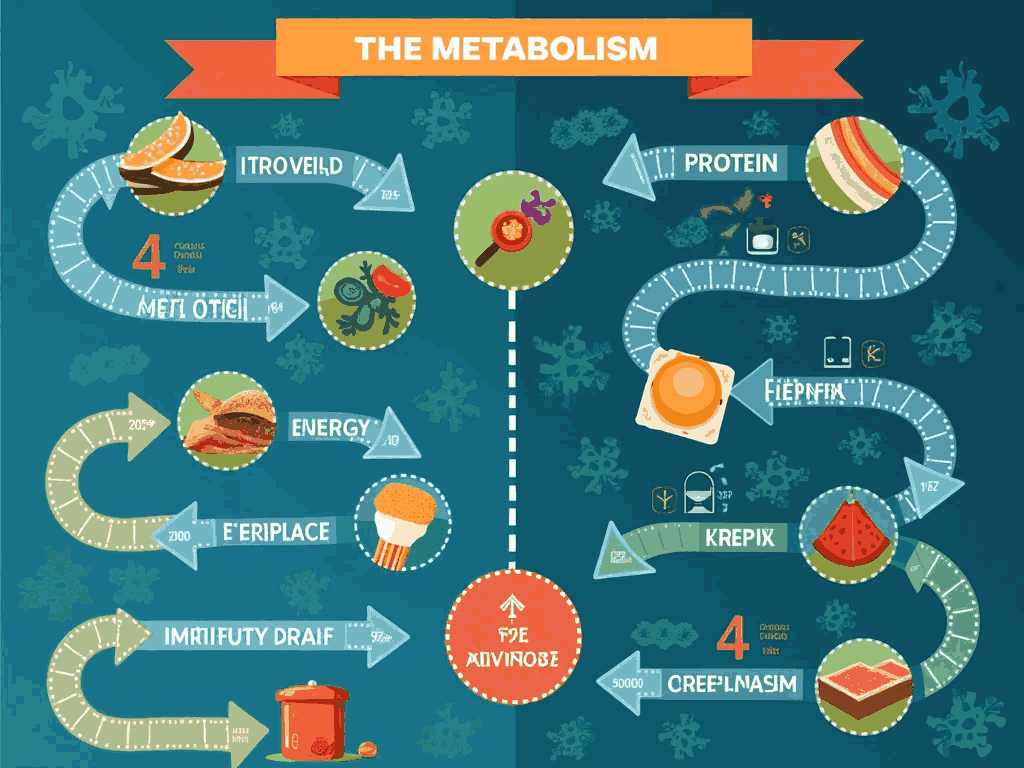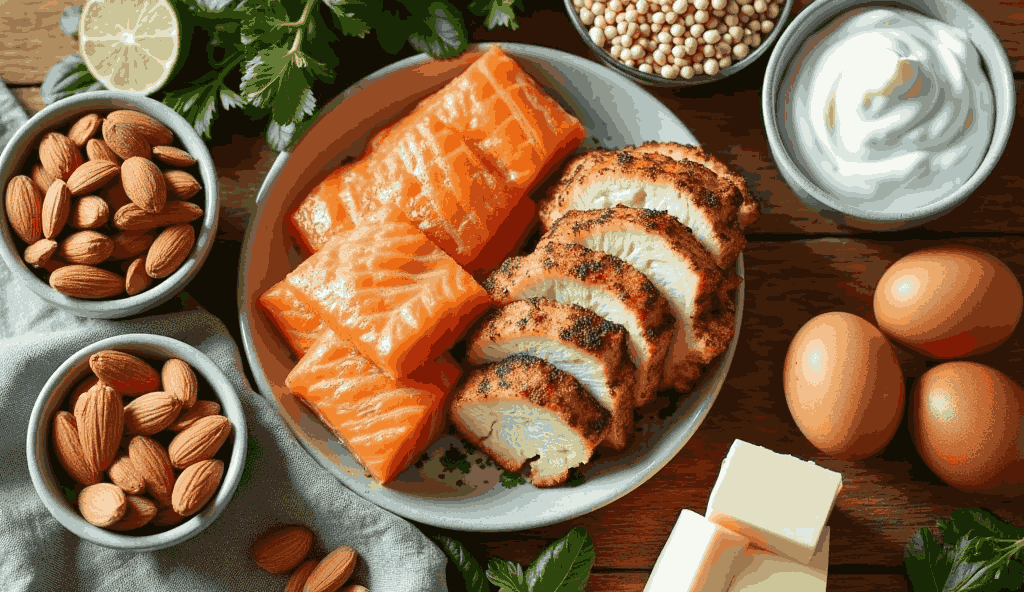Introduction
How to boost metabolism to lose fat. Four simple tips. Before incorporating these 4 simple steps to speed up fat loss through our metabolism, we must understand its components and how we can take advantage of each one to stay lean year-round. Let’s break it down.
What is Metabolism?
Metabolism is often broken into:
- Anabolism: The synthesis of proteins, carbohydrates, and fats that form tissue and store energy.
- catabolism: The breakdown of complex substances and the consequent production of energy and waste matter.
Regarding health and fitness, we loosely refer to it as our total daily energy expenditure, also known as our TDEE, the total number of calories you burn each day.
Your total energy expenditure is broken up into three major components:
| Component | Description |
|---|---|
| Basal Metabolic Rate (BMR) | The number of calories your body burns at rest for basic functions. |
| Physical Activity Level | The calories burned through exercise and daily movements. |
| Thermic Effect of Food (TEF) | The energy expended to digest, absorb, and store food. |
1. Basal metabolic rate (BMR)
Your BMR accounts for 50 to 70 percent of your daily energy needs. Factors influencing BMR include:
- Age
- Fat mass
- Fat-free mass
- Thyroid hormone levels
- Genetic predisposition
Your BMR is essentially how many calories your body burns per day to perform all of its basic metabolic functions, such as breathing, blood circulation, nutrient processing, and cell production.
In other words, if you sat on a couch all day long and did nothing but breathe, this would be roughly the number of calories you’d burn. This typically accounts for 50 to 70 percent of your daily energy needs.
Now, the body’s metabolic rate is influenced by various factors such as age, fat mass, fat-free mass, and thyroid hormone circulation. But some people’s bodies also naturally burn more energy than others.

2. Physical activity level
This generally constitutes 20 to 35 percent of your total caloric expenditure. One major component that dictates your physical activity level is the formal exercising routines such as weight lifting and cardio.
Within your physical activity is your NEAT, non-exercise activity thermogenesis. It includes typing at your desk, bringing groceries to the car, fidgeting, standing up from your desk, and even singing in the shower.
NEAT is just all the subconscious movements and light activities you do in a day. High levels of NEAT are advantageous from a fat loss perspective and are believed to be largely responsible for the massive difference in total metabolic rate we see.
Thermic Effect Of Food
NEAT is perfectly depicted in a 2014 study comparing the amount of NEAT burned in calories according to your occupation.

3. Thermic effect of food (TEF)
The third component of your total daily energy expenditure is the amount of energy expended by breaking down and processing food for use and storage. Simply put, your body burns calories as it digests, absorbs, transports, and stores food that you eat.
Protein: Increases metabolism by 15 to 30 percent
A high-protein diet is important because it will promote muscle growth and aid in its recovery, which is what we want to achieve. It can also increase the thermic effect of food, your TEF. It’s caused by the extra calories required to digest, absorb, and process the nutrients in your meal. Protein causes the largest rise in TEF.
It increases your metabolic rate by 15 to 30 percent, compared to five to 10 percent from carbs and zero to three percent from fats. In short, when we speak of metabolism, we’re speaking of the body’s ability to use various chemical processes to produce, maintain, and break down various substances and to make energy available for cells to use.
The faster the metabolism is, the more energy the body burns in performing many tasks related to staying alive. The slower it is, the less energy it burns performing these tasks. It would be highly likely you would consider yourself to have a slow metabolism or a fast one. I’ll be giving you 4 simple tips to boost your metabolism.

Heavy Resistance Training
Step one, is heavy resistance training at least three to six times a week. Long term, as you progress with your training and build more muscle tissue, your body will burn more calories at rest to sustain this newly added fat-free mass. A big reason why someone who’s at 200 pounds at 10 percent body fat can eat a lot more versus the person at 160 pounds at 10 percent.
Research also shows that resistance exercise increases your REE and adiponectin in an intensity-dependent manner for as long as 48 and 24 hours respectively, especially in overweight individuals. It appears that resistance exercise may represent an effective approach to weight management and metabolic control.
Enhances metabolic rate post-exercise (EPOC effect)
The increase in metabolic activity from the exercise can outlast your workout. Excess post-exercise oxygen consumption, also known as your EPOC, can last for more than a day after you stop exercising, depending on the duration and intensity of your physical activity.
In simple terms, your body will burn more calories overall training more frequently, consequently boosting your metabolism.
High-Protein Diet
Step two, a high-protein diet is important because it will promote muscle growth, which is what we want to achieve with step one. It can also increase the thermic effect of food.
It’s caused by the extra calories required to digest, absorb, and process the nutrients in your meal. As I mentioned, it increases your metabolic rate by 15 to 30 percent.
A common side effect of being on a diet is hunger. Protein’s ability to be satiating is a great way to curb your hunger and better help you with your dieting experience. I highly recommend that you eat roughly one gram of protein per pound of body weight when you’re working on speeding up your metabolism.
Water
Step three, drink more water. Studies have shown that drinking 17 ounces, roughly half a liter of water, increases your resting metabolism by 10 to 30 percent for about an hour.
Sleep
Step four is sleep. Inadequate sleep hurts both sides of your efforts to build muscle and lose fat.
Research shows that sleep deprivation causes hormonal disruptions that can cause muscle loss, which explains exactly why it’s been linked to muscular atrophy.
Conclusion
By incorporating resistance training, increasing protein intake, staying hydrated, consuming healthy fats, and getting sufficient sleep, you can effectively boost your metabolism and enhance fat loss. Small, sustainable changes make a significant difference over time.
FAQs
1. How long does it take to boost metabolism?
Results vary, but consistent changes in diet and exercise typically show effects within a few weeks to a couple of months.
2. Can I boost my metabolism without exercise?
Yes, through a high-protein diet, proper hydration, adequate sleep, and NEAT (daily movement), you can enhance your metabolic rate.
3. Do spicy foods boost metabolism?
Yes, capsaicin in spicy foods can slightly increase metabolism, but the effect is minor compared to other methods.
4. Does caffeine help with metabolism?
Yes, caffeine can temporarily increase metabolic rate by 3 to 11 percent, but it’s not a long-term solution.
5. How does age affect metabolism?
Metabolism slows as you age due to muscle loss and hormonal changes, but strength training and proper nutrition can help maintain it.

